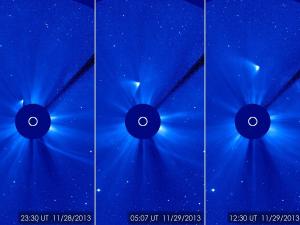Blog
Schrodinger’s Comet
30 November 2013
 SOHO
SOHOIf you’ve been following comet ISON, you’ve likely heard reports of its destruction, of its survival, fragmentation, etc. So what’s really going on? The short answer is that we’re still trying to find out.
The challenge comes from the fact that ISON is a sungrazing comet. That means its orbit takes it extremely close to the Sun at perihelion (closest distance to the Sun). Sungrazing comets have the chance of being quite bright (hence a lot of attention being placed on ISON), but their close approach to the Sun makes them somewhat unpredictable. Small sungrazing comets tend to evaporate from the intense heat of the Sun. Larger comets can survive the heat, but tend to break apart due to tidal forces from the Sun. ISON’s size put it in a kind of middle range of being large enough to survive the Sun’s heat, but possibly small enough to withstand the tidal forces.
Although the closest approach of a sungrazing comet is the most critical time, that is also the most difficult time to observe the comet. Even bright comets are faint compared to the Sun, so they can only be seen before sunrise or after sunset (the former in ISON’s case). At closest approach the comet simply can’t be observed by ground based telescopes. Instead we have to use solar observing telescopes such as SOHO, from which the image below is taken. SOHO is great for observing comets by their tails, but is not so great for observing details about the nucleus of a comet.
As ISON made its closest approach to the Sun, when it wasn’t seen as expected after closest approach there were some reports of it being destroyed. Later, evidence of at least a remnant of ISON were seen in SOHO images (seen above), hence the reports that ISON is still alive. In fact the status of ISON (at least as of this writing) is still a bit unclear. It is clear that something has survived closest approach, but observations are still determining whether it is a loose collection of dust that will soon evaporate away, or if a fractured nucleus still remains, in which case we might still have a bit of a comet show in December. The latest reports I can find seem to indicate that at least part of the nucleus remains.
When you hear contradicting reports from different sources, keep in mind that this is science in real time. Astronomers are focused on gathering information and making observations. The conclusions reporters draw from those observations can be sketchy. By next week we’ll have a much better picture of what has happened to ISON, and whether it is truly gone forever, or not.